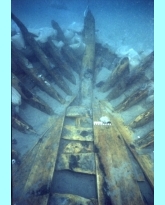
DW2 Shipwreck, 1998 Expedition
The DW2 wreck was excavated over a fortnight at the beginning of September 2001. The expedition included 50 Israelis: volunteers and students, the majority from the University of Haifa; and five members of the Nautical Archaeology Society of Great Britain headed by its chairman Chris Brandon. This wreck was previously excavated in a short rescue excavation in 1998 by a combined expedition of the Israel Antiquities Authority, Aqua Dora diving club and Recanati Institute for Maritime Studies. The working hypothesis date of the wreck, based on (1998) 14C analysis, is the middle of the 17th Century CE. There is a chance that this is the shipwreck reported sinking in the lagoon in 1664 by the merchant le Chevalier D'Arvieux. A significant amount of wood was found, including the keel, and end post, keelson, frames, planks, ceiling planking, mast step and other internal components. Among the small finds were several tobacco pipes, an oil lamp, a wooden comb and several ceramic vessels. A large amount of rope and concretions were found as well.
The preserved timbers of the hull remains were spread over an area 11.5 m by 3.7 m at a depth of 3.0 m. The wreck was found inclined longitudinally 9° downward to the NW and with a list of 7° to the SW. Except for hard wood treenails that had deteriorated, all other hull components were cut from well-preserved soft wood. The estimate length of the original ship is about 16 m. The ship was massively built and her construction indicates that the shipwrights had an abundance of poor quality raw material, and endeavored to reduce the shaping of the timbers to the minimum. From the condition of the preserved wood, it may be suggested that the ship was relatively new when it sank.